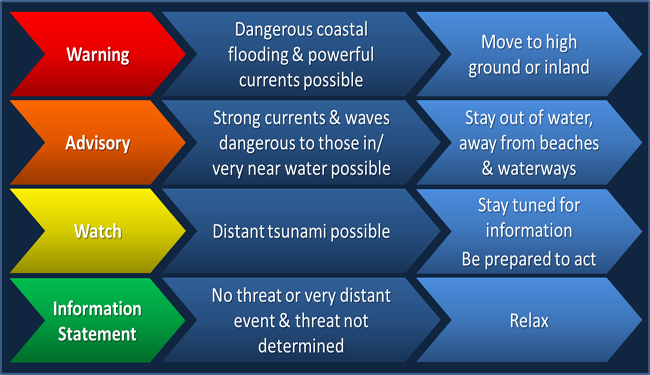Understanding Flood Alerts: Types, Warnings, And How To Respond

Table of Contents
Types of Flood Alerts and Warnings
Knowing the difference between various flood alerts is the first step in effective preparedness. Three main types of alerts are commonly used: flood watches, warnings, and advisories. These alerts, often part of a broader severe weather alert system, signify different levels of flood risk.
-
Flood Watch: A flood watch means that conditions are favorable for flooding. This isn't an immediate threat, but it's a signal to be prepared. Monitor weather reports closely, and review your emergency plan. A flood watch might be issued due to heavy rainfall, rapidly melting snow, or dam failure.
-
Flood Warning: A flood warning is serious. Flooding is happening or is imminent. Take immediate action to protect yourself and your property. This is the time to evacuate if instructed by local authorities.
-
Flood Advisory: A flood advisory indicates that minor flooding is occurring or is possible. While the threat is less severe than a warning, caution is still necessary. Avoid driving through flooded areas and remain vigilant.
Different regions utilize varying alert systems. For instance, the National Oceanic and Atmospheric Administration (NOAA) plays a significant role in the United States, providing flood forecasts and warnings. Local emergency services also issue alerts through their own channels, supplementing the national systems. These alerts might be integrated into your emergency alert system, alongside severe weather alerts.
Dissemination of Flood Alerts
Staying informed is paramount. Flood alerts are disseminated through various channels:
-
Weather Radio: A NOAA weather radio provides continuous updates on severe weather, including flood warnings and watches. It's crucial to have one, especially in flood-prone areas.
-
Mobile Alerts (Apps & SMS): Many weather apps and emergency alert systems (like those offered by FEMA) send alerts directly to your smartphone. Sign up for these alerts through your phone's settings or the app itself. Text alerts offer rapid notification even without internet access.
-
Local News: Television and radio stations often broadcast flood alerts and provide updates throughout an event.
-
Social Media: While not an official source, social media can provide real-time updates from affected areas. However, always verify information with official sources to avoid misinformation. This also includes checking government websites for local alerts.
Understanding Flood Hazard Maps
Knowing your flood risk zone is crucial. Flood hazard maps illustrate areas susceptible to flooding, categorizing them into different risk zones. These maps are essential for flood risk assessment and community planning.
-
Access flood hazard maps for your area through your local government's website or the FEMA website (fema.gov). These flood zone maps, also sometimes called flood plain maps, depict different flood risk levels.
-
Understanding these different flood risk zones – such as high-risk, moderate-risk, and low-risk – informs your preparation strategies. High-risk areas require more stringent preparedness measures compared to low-risk areas.
-
Flood hazard maps are instrumental in planning and preparedness. They help determine building codes, insurance rates, and the efficacy of mitigation strategies like drainage improvements.
How to Respond to Flood Alerts
Your response to a flood alert depends on its severity:
-
Flood Watch:
- Prepare an emergency kit containing essential supplies (water, food, medications, first-aid kit, etc.).
- Monitor weather reports closely and stay updated on the situation.
- Identify potential evacuation routes and have a plan for where to go.
-
Flood Warning:
- Evacuate immediately if instructed by local authorities. This is a critical step, often overlooked.
- Move valuable items to higher ground.
- Turn off utilities (electricity, gas) to prevent further damage.
-
Flood Advisory:
- Stay informed about the situation through official channels.
- Avoid driving or walking through flooded areas. The water may be deeper or faster flowing than it appears.
- Drive with extra caution; flooded roads can be dangerous.
Always follow the instructions from local authorities. They have the most up-to-date information on the situation and will prioritize your safety.
Post-Flood Actions
After a flood event, several important steps need to be taken:
-
Safety Precautions: Avoid entering flooded areas until authorities deem it safe. Be aware of potential hazards like downed power lines, damaged structures, and contaminated water.
-
Reporting Damage: Report flood damage to your insurance company and local authorities to facilitate aid and recovery efforts.
-
Cleanup: Clean up your property safely, paying careful attention to mold prevention. Dispose of damaged items appropriately.
-
Recovery: Contact relevant authorities and organizations for post flood recovery support.
Conclusion
Understanding and responding to different types of flood alerts is crucial for protecting yourself and your community. By knowing the difference between a flood watch, warning, and advisory, and by having a robust preparedness plan, you significantly reduce the risks associated with flooding. Staying informed through multiple channels—weather radio, mobile alerts, and local news—is vital. Proactively prepare for floods by signing up for flood alerts in your area, reviewing your flood risk assessment, and developing a comprehensive personal flood preparedness plan. Remember, preparedness is key to mitigating the devastating impacts of flooding. Learn to understand flood alerts and take the necessary steps to ensure your safety.

Featured Posts
-
 Sean Penn Casts Doubt On Dylan Farrows Sexual Assault Claims
May 25, 2025
Sean Penn Casts Doubt On Dylan Farrows Sexual Assault Claims
May 25, 2025 -
 Euroleague I Niki Tis Monako Epireazei Ti Vathmologia
May 25, 2025
Euroleague I Niki Tis Monako Epireazei Ti Vathmologia
May 25, 2025 -
 The Hells Angels Fact Vs Fiction
May 25, 2025
The Hells Angels Fact Vs Fiction
May 25, 2025 -
 Private Credit Jobs 5 Tips To Succeed In A Competitive Market
May 25, 2025
Private Credit Jobs 5 Tips To Succeed In A Competitive Market
May 25, 2025 -
 Positief Beurzenklimaat Na Trump Uitstel Aex Prestaties Onder De Loep
May 25, 2025
Positief Beurzenklimaat Na Trump Uitstel Aex Prestaties Onder De Loep
May 25, 2025
